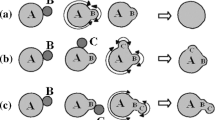Abstract
The heat capacity of copper and nickel clusters (from 2 to 6 nm in diameter) was investigated in the temperature range 200–800 K using molecular dynamics method and a modified tight-binding potential. The simulation results demonstrate a very good agreement with the available experimental data at T = 200 K and a fairy good agreement at higher temperatures. A number of regular trends are revealed in computer experiments which agree with the corresponding theoretical predictions. A conclusion is made that in the case of single free clusters the heat capacity may exceed the capacity of the corresponding bulk material. It is found that at 200 K, the copper nanocluster (D = 6 nm) heat capacity is higher by 10% and for nickel cluster by 13%. The difference diminishes with increasing the nanoparticles size proportionally to the relative number of surface atoms. A conclusion is made that very high values of the nanostructure heat capacity observed in laboratory experiments should not be attributed to free clusters, i.e., the effect in question is caused by other reasons.



Similar content being viewed by others
References
Chen YY, Yao YD, Jen SU et al (1995a) Magnetic susceptibility and low temperature specific heat of palladium nanocrystals. Nanostruct Mater 6:605–608
Chen YY, Yao YD, Lin BT et al (1995b) Specific heat of fine copper particles. Nanostruct Mater 6:597–600
Cheng HP, Li X, Whetten RL, Berry RS (1992) Complete statistical thermodynamics of the cluster solid-liquid transition. Phys Rev A 46:791–800
Cleri F, Rosato V (1993) Tight-binding potentials for transition metals and alloys. Phys Rev B 48:22–33
Comsa GH, Heitkamp D, Rade HS (1976) Specific heat of ultrafine vanadium particles in the temperature range 1.3–10 K. Solid State Commun 20:877–880
Gafner SL, Redel LV, Gafner YY (2009) Simulation of the processes of structuring of copper nanoclusters in terms of the tight-binding potential. JETP 108:784–799
Goll G, Lohneyen H (1995) Specific heat of nanocrystalline and colloidal noble metals at low temperatures. Nanostruct Mater 6:559–562
Gu MX, Sun CQ, Chen Z, Au Yeung TC, Li S, Tan CM, Nosik V (2007) Size, temperature, and bond nature dependence of elasticity and its derivatives on extensibility, Debye temperature, and heat capacity of nanostructures. Phys Rev A 75:125403
Gusev AI (2005) Nanomaterials, nanostructures and nanotechnologies. Fizmatlit, Moscow, p 416
Hoover WG (1985) Canonical dynamics: equilibrium phase-space distributions. Phys Rev A 31:1695–1697
Kusche R, Hippler Th, Schmidt M, Issendorf B, Haberland H (1999) Melting of free sodium clusters. J Eur Phys D 9:1–4
Lai SK, Lin WD, Wu KL, Li WH, Lee KC (2004) Specific heat and Lindemann-like parameter of metallic clusters: Mono- and polyvalent metals. J Chem Phys 121:1487–1498
Liu CS, Xia J, Zh ZG, Sun DY (2001) The cooling rate dependence of crystallization for liquid copper: a molecular dynamics study. J Chem Phys 114:7506–7512
Makarov GN (2010) Experimental methods for determining the melting temperature and the heat of melting of clusters and nanoparticles. Phys Usp 53:179–198
Morokhov ID, Petinov VI, Trusov LI, Petrunin VF (1981) Structure and properties of fine metallic particles. Sov Phys Usp 24:295–317
Nonnenmacher ThP (1975) Quantum size effect on the specific heat of small particles. Phys Lett A 51:213–214
Nosé S (1984a) A molecular dynamics method for simulations in the canonical ensemble. Mol Phys 52:255
Nosé S (1984b) A unified formulation of the constant temperature molecular dynamics methods. J Phys Chem 81:511–519
Pang T (2006) An introduction to computational physics. Cambridge University Press, Cambridge, p 385
Qi Y, Cagin T, Johnson WL, Goddart WA (2001) Melting and crystallization in Ni nanoclusters: the mesoscale regime. J Chem Phys 115:385–394
Rupp J, Birringer R (1987) Enhanced specific-heat-capacity (cp) measurements (150–300 K) of nanometer-sized crystalline materials. Phys Rev B 36:7888–7890
Salian UA (1998) Microcanonical temperature and “heat capacity” computational of Lennard-Jones clusters under isoergic molecular dynamics simulation. J Chem Phys 108:6342–6346
Schmidt M, Kusche R, Kronmüller W, Issendorf B, Haberland H (1997) Experimental determination of the melting point and heat capacity for a free cluster of 139 sodium atoms. Phys Rev Lett 79:99–102
Sun CQ (2007) Size dependence of nanostructures: impact of bond order deficiency. Prog Solid State Chem 35:1–159
Suzdalev IP (2006) Nanotechnology: physico-chemistry of nanoclusters, nanostructures and nanomaterial. ComKniga, Moscow, p 592 (in Russian)
Trampenau J, Bauszus K, Petry W, Herr U (1995) Vibrational behavior of nanocrystalline Ni. Nanostruct Mater 6:551–554
Yao YD, Chen YY, Hsu CM et al (1995) Thermal and magnetic studies of nanocrystalline Ni. Nanostruct Mater 6:933–936
Zemlyanov MG, Paganova GKh, Syrykh GF, Shikov AA (2006) Size effects on the vibrations of Cu-Pb nanocomposites. Phys Solid State 48:139–143
Acknowledgments
This article was prepared under the financial support of Russian Foundation for Basic Research (grant No. 10-02-98-001-r_Siberia_a), grant of President of Russian Federation (No. MK-2207.2009.2) and in frames of the research program “Scientific and pedagogical stuffs of the innovation Russia 2009–2013”.
Author information
Authors and Affiliations
Corresponding author
Rights and permissions
About this article
Cite this article
Gafner, S.L., Redel, L.V., Gafner, Y.Y. et al. Peculiar features of heat capacity for Cu and Ni nanoclusters. J Nanopart Res 13, 6419–6425 (2011). https://doi.org/10.1007/s11051-011-0394-z
Received:
Accepted:
Published:
Issue Date:
DOI: https://doi.org/10.1007/s11051-011-0394-z



